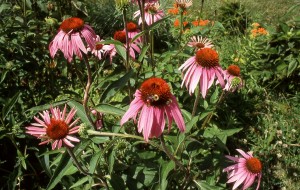If you are having a bad day, skullcap herb (scutellaria spp.) is one of the more recognizable herbs used for nervous disorders in today’s herbalism. It is considered an antispasmodic, antibacterial, cooling, diuretic, and promotes bile flow.
It was used by the Native Americans for treatment of rabies, menstrual problems and to bring on menstrual period, quiets cramps, soothes breast pain, and ease kidney problems.
Scutellaria lateriflora, also known as Blue Skullcap, Hoodwort, Virginian Skullcap, Mad-dog Skullcap is a hardy perennial herb native to North America. It is a member of the mint family.
- Height: 1-3 feet, with branching stems and oval toothed leaves.
- Flowers: Pretty tiny blue flowers emerge along the stem in mid-summer.
- Roots are stringy and yellow and should be at least 3 years old before harvesting.
- Cultivation: Grows in ordinary well drained soil in sun or light shade.
- Propagation: Sow seeds in late winter, and divided root in early spring.
Medicinal: The whole plant is considered medicinal. Scullcap nourishes and revitalizes the nervous system, thanks to the minerals it supplies, which include calcium, iron, potassium and magnesium.
It is good in times of stress, easing tension headaches, stress, anxiety, exhaustion and depression. May help to promote sleep, and won’t leave you feeling groggy in the morning.
Scullcap is calming for many nervous conditions and has a tonic effect on the central nervous system and helps with nervous fatigue and hysteria. An antispasmodic is a drug or an herb that suppresses muscle spasms.
Scullcap is very quieting and soothing to the nerves of people who are easily excited. It is used in such diseases such as shaking palsy, convulsion, fits, rheumatism, hydrophobia, epilepsy, and bites for poisonous insects and snakes.
Scullcap is used medicinally as a strong tea also known as an infusion for insomnia and as a tincture for extreme anxiety or pms.
The tincture is best using the fresh herb and a strong alcohol such as 190 proof. Mix with lemon balm for depression.
Root: Make a decoction with the root and mixed with other herbs that are considered cold and bitter.
Caution: Can be mistaken for germander which should not be taken in large doses. In some US markets Germander is sold as Scullcap. Germander can cause liver toxicity.

